✓ Free Legal Expenses Cover up to £100,000
✓ Great Value Multi-Bike Rates
✓ Accessory and Modification Cover
✓ Short Term Cover from One Day to Three Months
✓ Cover for Convicted Riders
✓ Laid-Up Cover
✓ Agreed Value
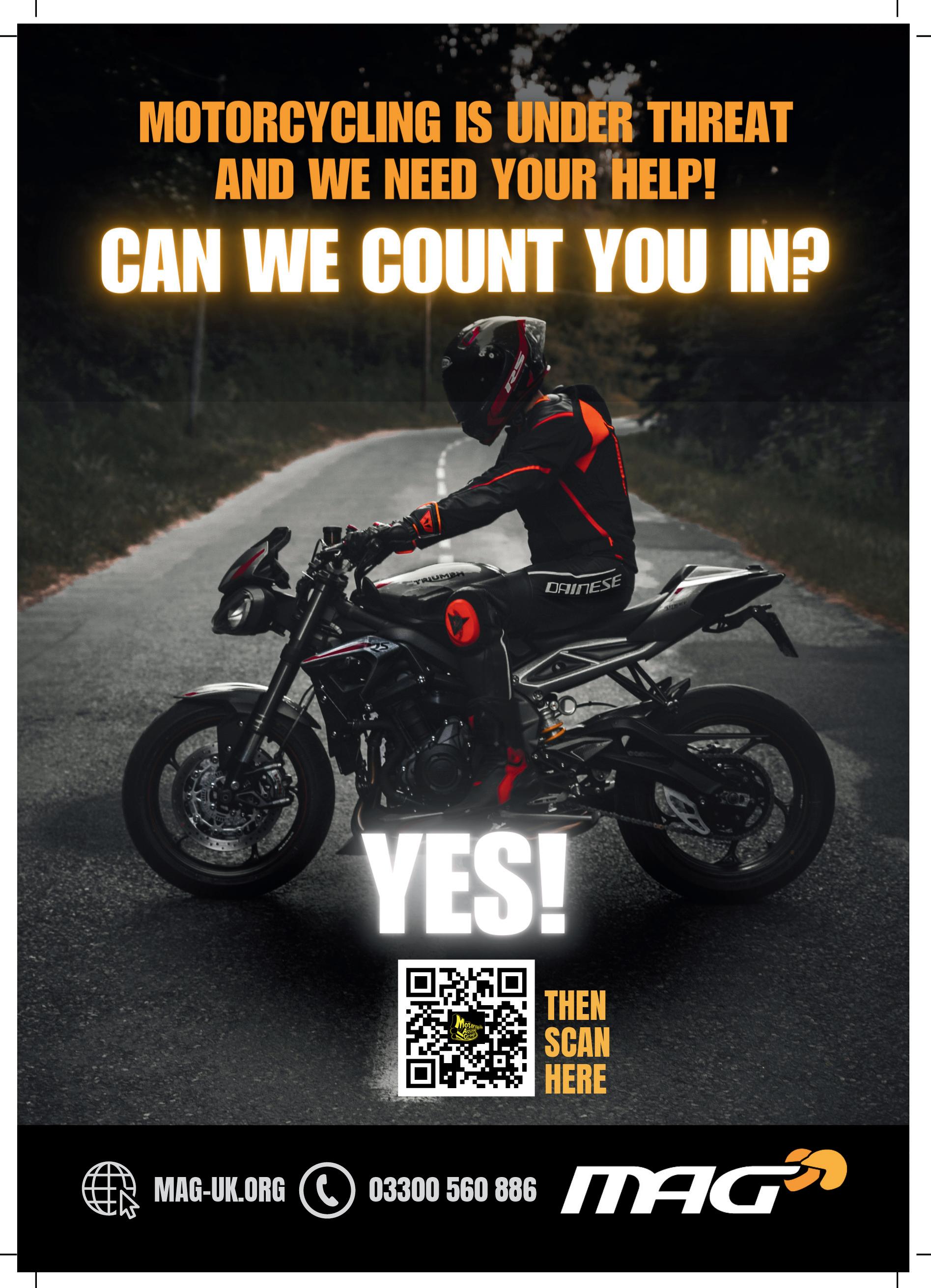

✓ Free Legal Expenses Cover up to £100,000
✓ Great Value Multi-Bike Rates
✓ Accessory and Modification Cover
✓ Short Term Cover from One Day to Three Months
✓ Cover for Convicted Riders
✓ Laid-Up Cover
✓ Agreed Value

Choosing two wheels rather than four is a lot of fun, but there are
Welcome to motorcycling. Or should that be ‘welcome back’?
Whether you are new to the world of powered two-wheelers, or returning after a long break, you’re really going to enjoy motorcycling. There’s nothing quite like it.
You can list lots of sensible reasons for getting a motorbike, but the thrill of riding is number one for a lot of bikers. The downside is
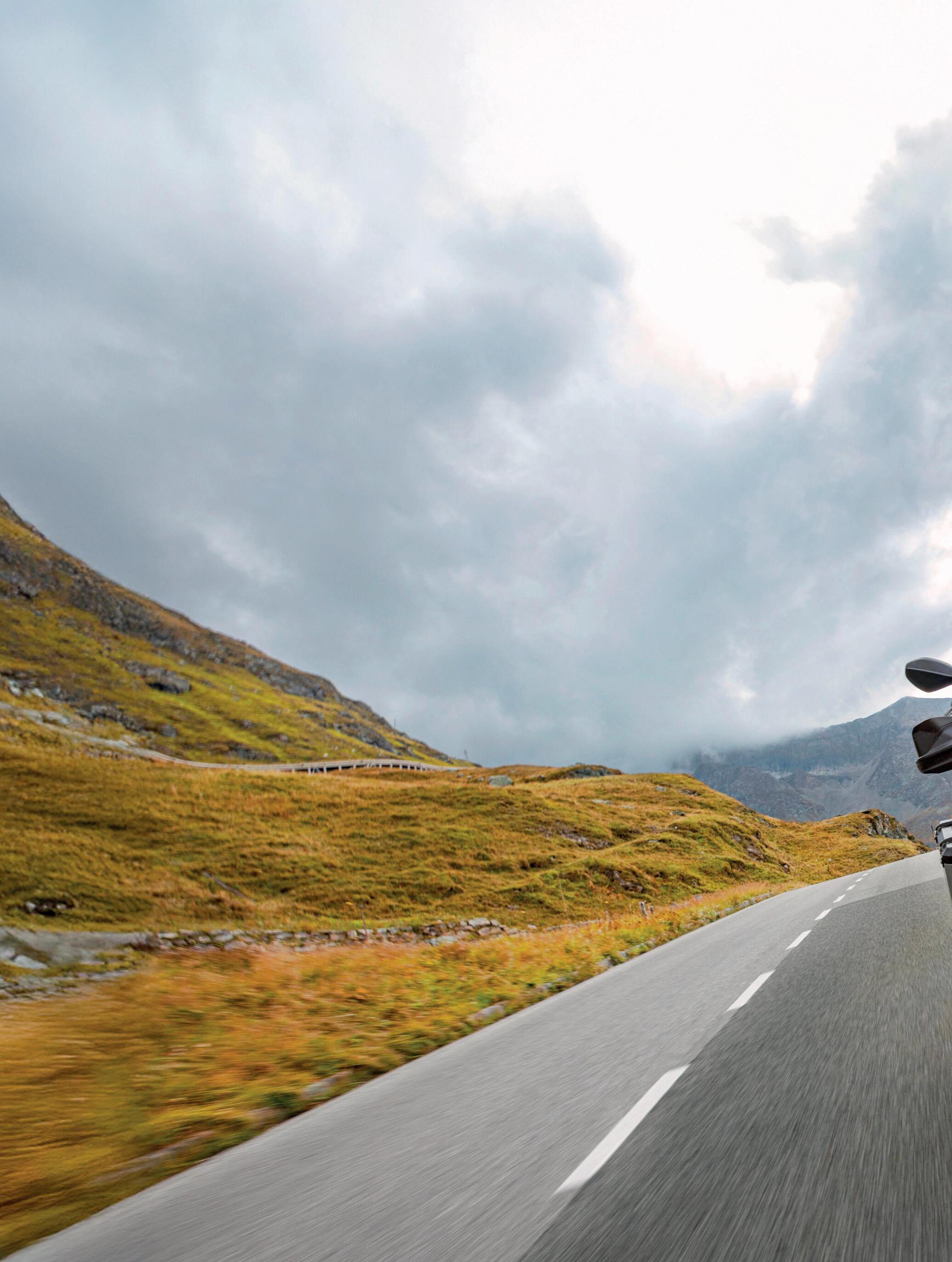
“THE LIST OF REASONS TO CHOOSE TWO WHEELS OVER FOUR IS A LONG ONE. LIKE MOST OF LIFE’S PLEASURES, MOTORBIKES ARE BEST ENJOYED RESPONSIBLY“
that statistics show riding a bike is more dangerous than driving a car.
There are 67 fatalities per billion passenger kilometres for motorcycles on Britain’s roads (source: Statista). That compares with just 1.1 deaths per billion passenger kilometres for car travel. So in travelling by bike rather than car, you are choosing a riskier way of getting from A to B. Of course, there are steps you can take to reduce the risk involved, which we’ll cover in detail throughout this magazine. What’s
more, not all the statistics around motorcycle safety make such grim reading. According to the government, between 2004 and 2020 annual motorcycle fatalities reduced from 585 to 285. Serious injuries fell by 48% over the same period. So while motorcycling is more dangerous than driving, it’s much safer than it used to be.
For many of us, the advantages of motorcycling outweigh the risks. Commute by bike, and you’ll get to work more quickly. Ask anyone who has swapped four
wheels for two and they’ll tell you the same.
You’ll save money, too. With fuel prices so high, the efficiency of a motorbike can’t be ignored. A Honda CB125F returns a claimed 145mpg, compared with 42.8mpg for a Honda CR-V hybrid. That’s good for your pocket, and good for the environment.
You’ll be quids in when it comes to vehicle tax as well. Even a 600cc+ bike will cost just £111 per year

in tax. A petrol or diesel car costing over £40,000 will set you back £570 per year.
Insurance costs will vary depending on a whole host of factors, but according to Compare the Market, the average motorbike premium is £77 less than the average price of car insurance.
The list of reasons to choose two wheels rather than four is a long one, although there’s no denying the extra risk. Like most of life’s pleasures, motorbikes are best enjoyed responsibly.
FUEL BILL FROM LANDS END TO JOHN O’GROATS
BIKE: Honda CB125F £ 37.55
CAR: Honda CR-V Hybrid £127.21
VEHICLE TAX (ANNUAL)
BIKE: 600cc+ motorbike £117
CAR: £40k+ petrol car £620
INSURANCE COST (AVERAGE)
BIKE: £652
CAR: £729
Here’s what you need to know before hitting the road
If you passed your driving test before 1 February 2001 you will already have a provisional ‘Category A’ licence, so you’re eligible for Compulsory Basic Training (CBT). If you passed more recently, you’ll need to apply at gov.uk/apply-firstprovisional-driving-licence, which costs £34.
Over a day or two, you’ll learn the basics of how to control a motorbike, along with defensive riding and the Highway Code. You’ll then spend a couple of hours on the road. When the instructor feels you have reached a safe standard you’ll be issued with the DL196 (CBT) certificate. This is valid for two years. You can now ride an 11kW 125cc bike with L-plates, but no pillion passengers and you can’t use the motorway. If you don’t pass the theory and practical within two years you’ll need to redo the CBT.
There are two parts to the theory test; multiple choice questions, and the hazard perception test. You need to score at least 43 out of 50 in the multiple choice section and 44 out of 75 in the hazard perception test. The test costs £23. You can take the theory test before completing CBT if you prefer.
Module 1 is off road and Module 2 is on the road.
You must pass Module 1 before moving on to Module 2. Module 1 takes around 20 minutes, and you’ll need to show you can corner, brake, and make an emergency stop safely.


Module 2 lasts around 40 minutes, and includes an eyesight check, ‘show me, tell me’ safety questions, road riding, and independent riding (without an examiner directing you). A Module 1 test costs £15.50, a Module 2 test costs £75 on a weekday and £88.50 in the evening or on a weekend.
Whatever your age, once you have passed the practical test
DIRECT
ACCESS IF YOU ARE 24 OR
OVER YOU CAN TAKE YOUR PRACTICAL TEST ON ANY TYPE OF BIKE, SO YOU CAN GO STRAIGHT TO A ‘CATEGORY A’ LARGE BIKE.
you can ride without L-plates, take pillion passengers, and use the motorway. However, you are restricted to riding the class of motorbike you took your test on. For anyone aged 17-18 that means nothing more powerful than an A1 bike (11kW), for riders aged 19-23 an A2 bike (35kW), while riders over 24 can ride a Category A bike, so long as that’s what they rode when taking the practical.



“I’ve just taken my CBT. There was a lot to take in for a novice, but my confidence and skills improved as the day went on. Now I’ve completed the course I’m riding a Vmoto Stash electric motorbike on L-plates. It’s great fun and very cheap to run, but I’m looking forward to taking my theory and practical test so I can keep progressing.” David, Surrey


What to expect, and how to pass your theory test
Prep well to pass your practical test first time

Post-test training helps make the most of your potential as a biker
The better you ride, the more enjoyable biking becomes. There are few things as satisfying as honing a new skill, and with motorcycles there are so many new skills to learn. When we first get on the
road, we’re at the bottom of the curve. Even after earning your A licence there’s still so much to learn to stay safe and be a better biker.
Motorcycling isn’t just a way of getting around. When you become a rider,
you become part of a community, and many bikers are passionate about sharing their enthusiasm through formal post-test training and the many clubs and groups around the country. Think back to when you



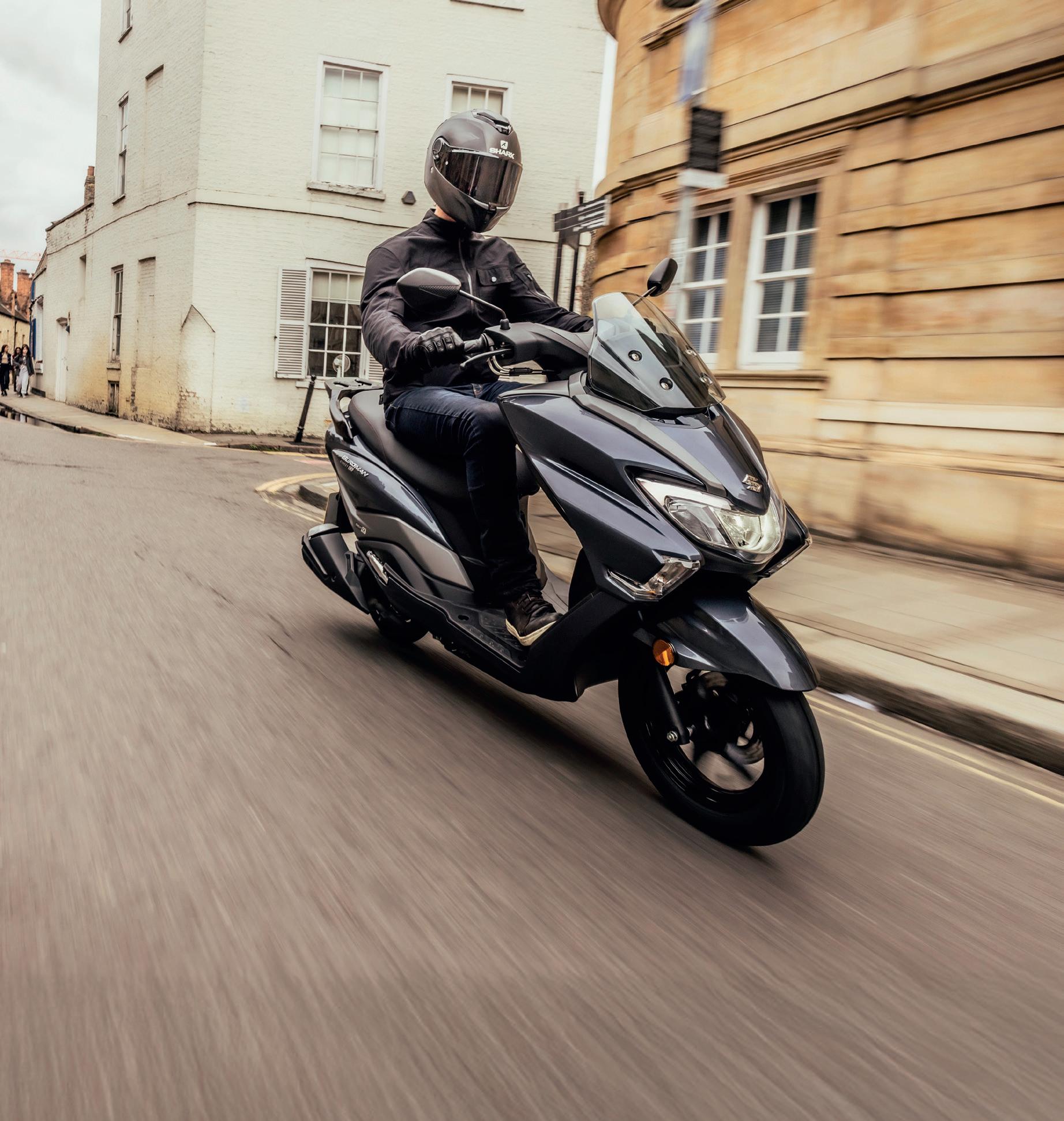
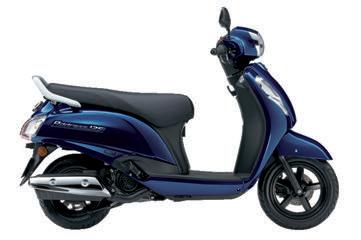




big and heavy. Some have high seats, so may not suit shorter riders.
BUY IF… you’ve always dreamed of riding around the world.
AVOID IF… the seat height is too high for you.
A touring bike has many of the advantages of an adventure bike, but without the remit to handle dirt tracks as well as Tarmac roads. These bikes are all about travelling long distances in great comfort.
You won’t enjoy the thrills of a sports bike, but you will be sat upright without too much strain on your wrists or back. Expect the suspension to smooth out the road.
is a definite plus. It’s handy for taking a change of clothes to work or picking up some shopping.
Luxury goodies that would add unnecessary weight to a sports bike are more common on tourers, such as radios and heated handlebar grips.
BUY IF… you value practicality and comfort.
AVOID IF… you want an exciting ride.
A true ‘custom’ bike is one that’s been modified from the stock design, but the term is also applied to off-theshelf models with a ‘custom’ look. The most obvious examples are made by Harley-Davidson, but many big brands have a few custom models (or cruisers) in their line-up.
Why buy a custom bike? First and foremost, because you love the way they look. These bikes are all about style. The

Even if you aren’t going to tour around Europe on your bike, the extra storage a tourer provides

second reason is often the sound they make. It’s just so evocative and takes the imagination straight to some sun-kissed Californian highway.
If you need more rational reasons, riding positions are usually relaxed and the saddle heights are generally low, so the bikes suit shorter riders well.
On the other hand, a custom bike won’t handle like a sports machine, and a tourer is usually more practical.
BUY IF… you’re in love with the style and image.
AVOID IF… you want something sporty.

A naked bike is one without a fairing to improve aerodynamics and keep the rider out of the wind. Sometimes called standard bikes or roadsters, lots of new riders start out on naked machines before progressing to something more specialised.
You want a bike to commute on? A naked bike can do that. You want a bike for some weekend fun? A naked bike can do that too. It doesn’t necessarily excel in any one area but it will do just about anything you ask of it.
As a rule of thumb, naked bikes are less expensive and more fuel efficient than adventure bikes and sports machines. Middling saddle heights make naked bikes well suited to riders of most shapes and sizes, and a reasonably upright riding position keeps things comfortable.
On the other hand, if you want to travel long distances on the motorway you might miss having a fairing. Or if outright thrills are your priority, you may prefer a sports bike.
BUY IF… you want a good all-rounder.
AVOID IF… regular long rides are on the cards.
A modern classic bike is one designed to look like a bike from an earlier era. So if you grew up in the ’70s desperate to ride a Kawasaki Z1, you can now buy the modern equivalent.
Nostalgia plays a big part in choosing a modern classic, but it’s not necessarily a headover-heart purchase. You get retro looks without the oil leaks and iffy brakes of an old bike. If you haven’t got the time, patience, or mechanical knowledge to maintain a classic machine, a modern
retro motorcycle offers the best of both worlds.
As day-to-day machines, modern classics have a lot in common with naked bikes. They generally won’t have a fairing and will lack the storage options of a tourer. They won’t handle with the agility and precision of a modern sports bike, but with the advances in suspension, braking and tyres over recent decades they won’t be slouches either.
BUY IF… retro style is all important.
AVOID IF… you want something sportier or more practical.
“CHOOSE A MODERN CLASSIC, AND YOU GET RETRO LOOKS WITHOUT THE OIL LEAKS AND IFFY BRAKES OF AN OLD BIKE“
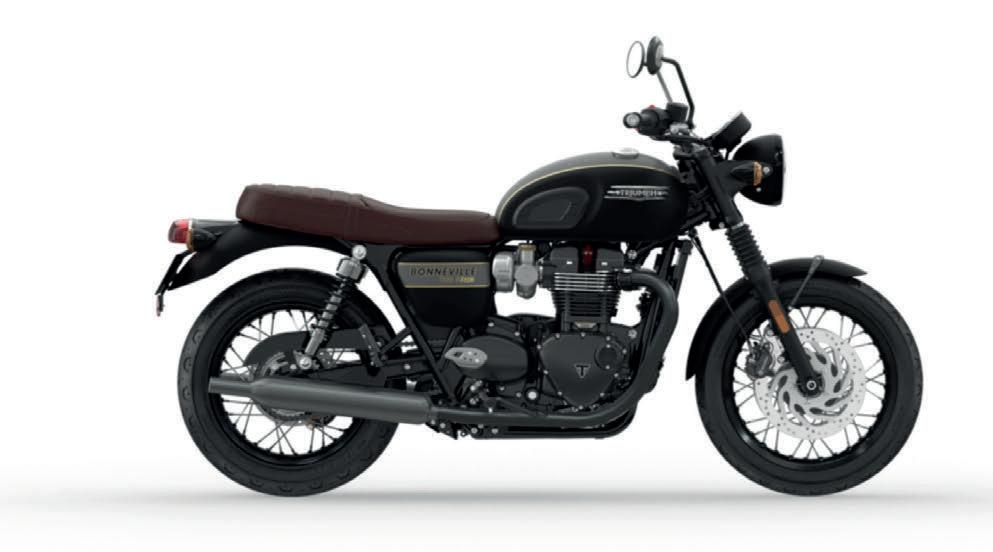
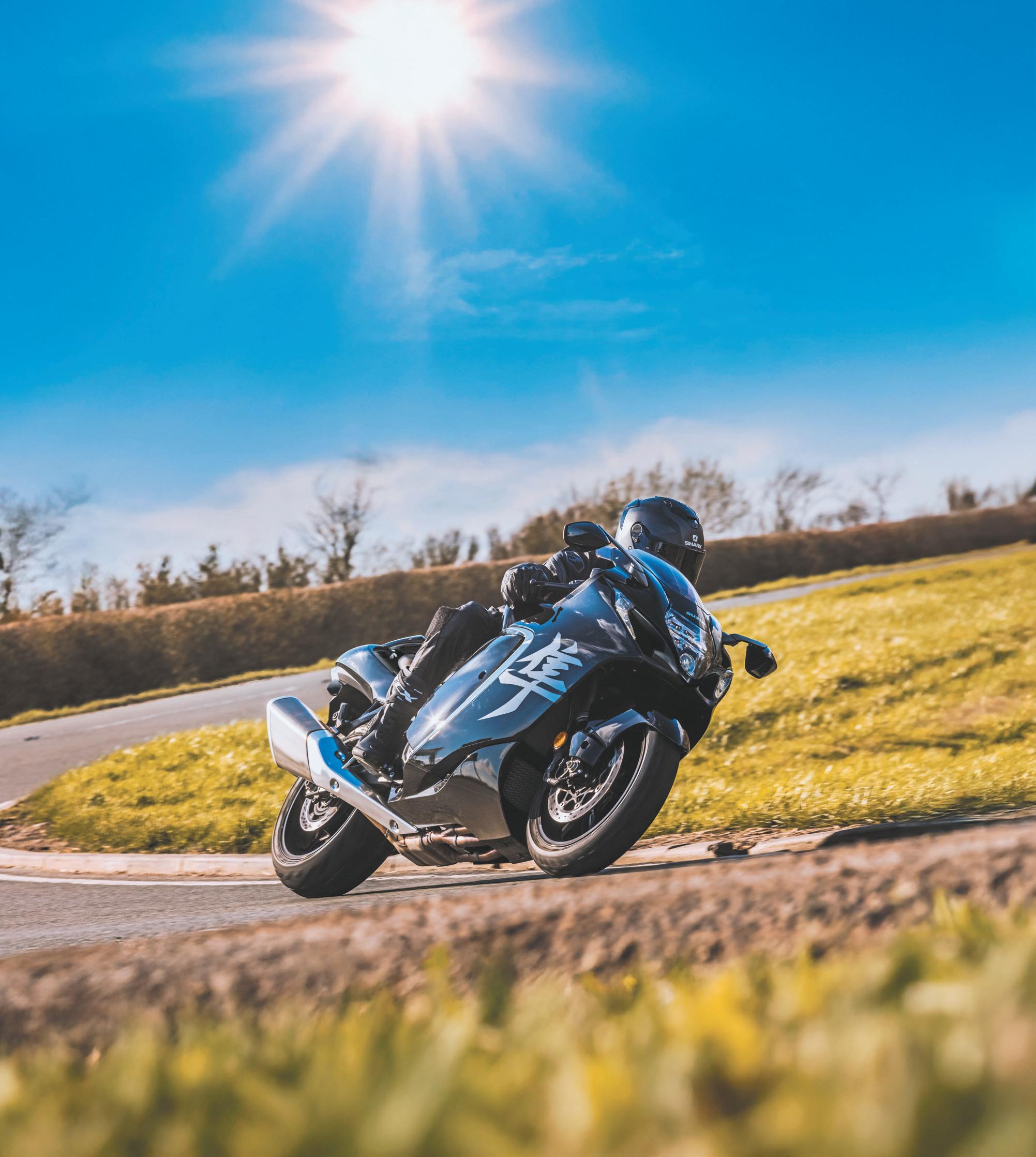
SO, HOW DOES IT WORK?
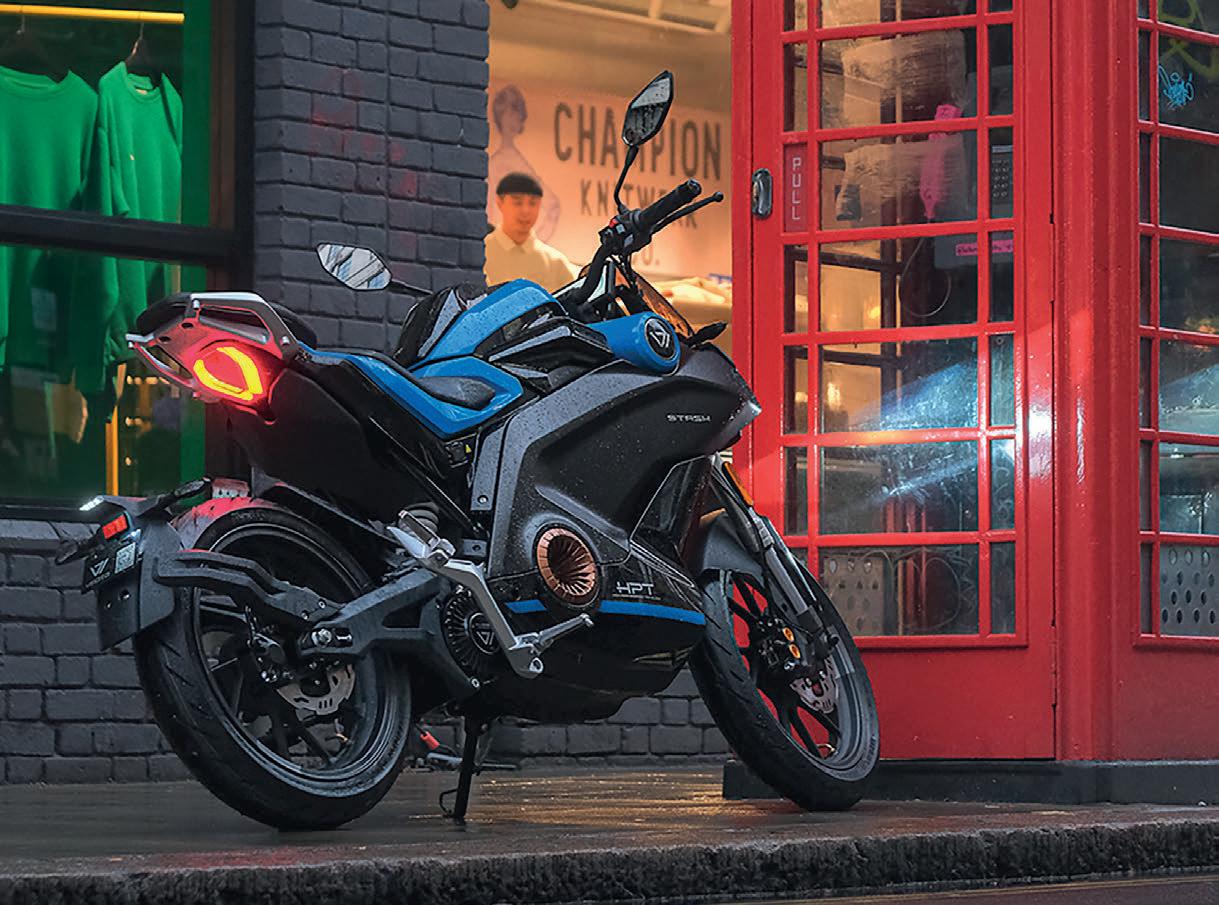
Is it time you swapped petrol for battery power?
While electric cars have become part of the mainstream, electric motorbikes haven’t caught on quite so quickly. But while progress has been slow, bikers who have made the change rave about quiet running, easy riding, and surprising performance.
It’s easy to see the appeal. With fuel prices so high, an electric two-wheeler promises rock-bottom running costs. What’s more, you can get your kicks without any guilt over exhaust emissions.
On the other hand, electric bikes are typically more expensive to buy. Here are the pros and cons to consider before you decide to make the switch.
● Better for the environment. An electric bike has no exhaust emissions.
● Low running costs. Recharge at home from a domestic socket, and you could pay as little as 2p per mile.
● Instant performance. Electric motors deliver maximum torque from the first twist of the throttle, so they accelerate hard from a standing start.
● Quiet running. With almost no noise or vibration, riding an electric bike is a chilled experience.
● Easy to ride. Electric bikes have one forward gear, so riding one is simple.
● Expensive to buy. You can expect to pay more than for a similar petrol. For example, the 125cc-equivalent Vmoto Stash costs £6299.
● Noise and vibration are all part of the fun. Many riders will miss the sound and character of petrol power.
● Range anxiety. Many electric bikes have a realworld range of less than 100 miles.
● Charging time. Topping up a fuel tank takes a few minutes. Topping up batteries takes a few hours.
● Choice. There aren’t as many electric bikes as there are petrol ones, so your choice at a given price point won’t be as broad.






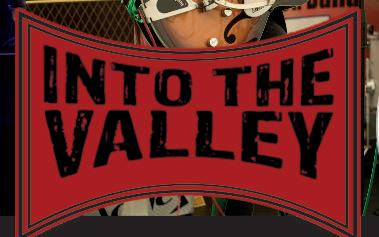



Our pick of the best models for every kind of A licence

Motorcycles up to 11kW (and a powerto-weight ratio not more than 0.1 kW per kg) and 125cc.
TOP OF THE CLASS
Suzuki GSX-S125
From £4999
Great looks, comfort, and nimble handling make the GSX a great first bike. The punchy engine means the Suzuki isn’t out of its depth on A-roads.
ALSO CONSIDER...
Kymco Agility City+ 125
From £2559
The Kymco is affordable to buy and run, but still offers plenty of performance for commuting. A combined braking system makes for simple, confident stopping.


Zero DS
From £16,200
The electric DS is pricey but delivers a big-bike riding experience for A1-licence holders. It’s much quicker than any petrol 125cc bike, with a real-world range of around 100 miles.

Around 2000 motorcycles and scooters are stolen each month. Here’s how to make sure yours is not one of them
BWHETHER YOUR BIKE IS AT HOME, or you need to leave it on the street, it’s always a target for thieves. There are lots of simple steps you can take to cut the risk of criminals stealing your bike.
1: LOCK IT INSIDE
Keep your bike garaged. Ideally fit a garage door defender, which makes it much harder for a thief to open up-and-over garage doors. If you don’t have a garage, a sturdy motorbike
storage shed is the next best thing. If the bike is kept securely out of sight it’s a much less obvious target for thieves.
2: KEEP IT CHAINED UP
If possible, install a ground anchor at home and chain the bike to it. If you don’t have a ground anchor, still use a stout security chain that’s highly rated by the security experts at Thatcham (thatcham.org) and Sold Secure (soldsecure. com). Products which meet Sold Secure’s Diamond and
“A GOOD QUALITY D-LOCK WILL SLOW DOWN A THIEF OR PERSUADE THEM TO PINCH A BIKE THAT’S LESS WELL PROTECTED”
Similar to the systems used in cars, ride modes allow you to tailor the bike’s reactions to suit you and the conditions. Most set-ups let you choose between modes using a button on the handle bars, so you can pick between Road, Rain, and Sport modes. Some will also offer Track or Off-road settings depending on the type of motorcycle, and they all work to vary engine power, traction control and ABS limits to give you maximum command.
Common on many highpowered motorcycles, traction control prevents the rear wheel from spinning. It’s a real help on wet or slippery roads, and most systems offer different modes for varying riding conditions, such normal, wet and track use.
New technology on motorcycles lets you take more control of your ride


Anti-lock braking systems (ABS) are standard on all new bikes over 125cc and are now so sophisticated you won’t notice them in normal riding. In an emergency, ABS lets you steer even with maximum braking, so it’s worth practising with it on a quiet road so you know how this life-saving tech feels.


There’s a wide range of cameras available to record your ride for fun or to use in the event of a collision. Helmet-mounted cameras give a rider’s eye view, but they can cause more wind noise and turbulence, and they can damage your helmet in a collision.


The big debate with sat nav is a dedicated unit versus using your smartphone. A phone is generally easier to set up, especially if you use an integrated charger. The downside of a phone is that sat nav and Bluetooth drain the battery and the phone can get very hot. An integrated system, such as a Garmin or Beeline, uses less power and comes with waterproof screens with clear instructions. Be sure any sat nav has Bluetooth to connect to a wireless headset to give verbal instructions so you can keep your eyes on the road.
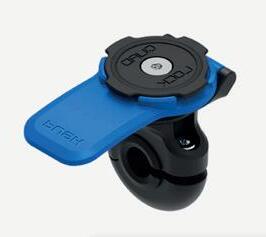
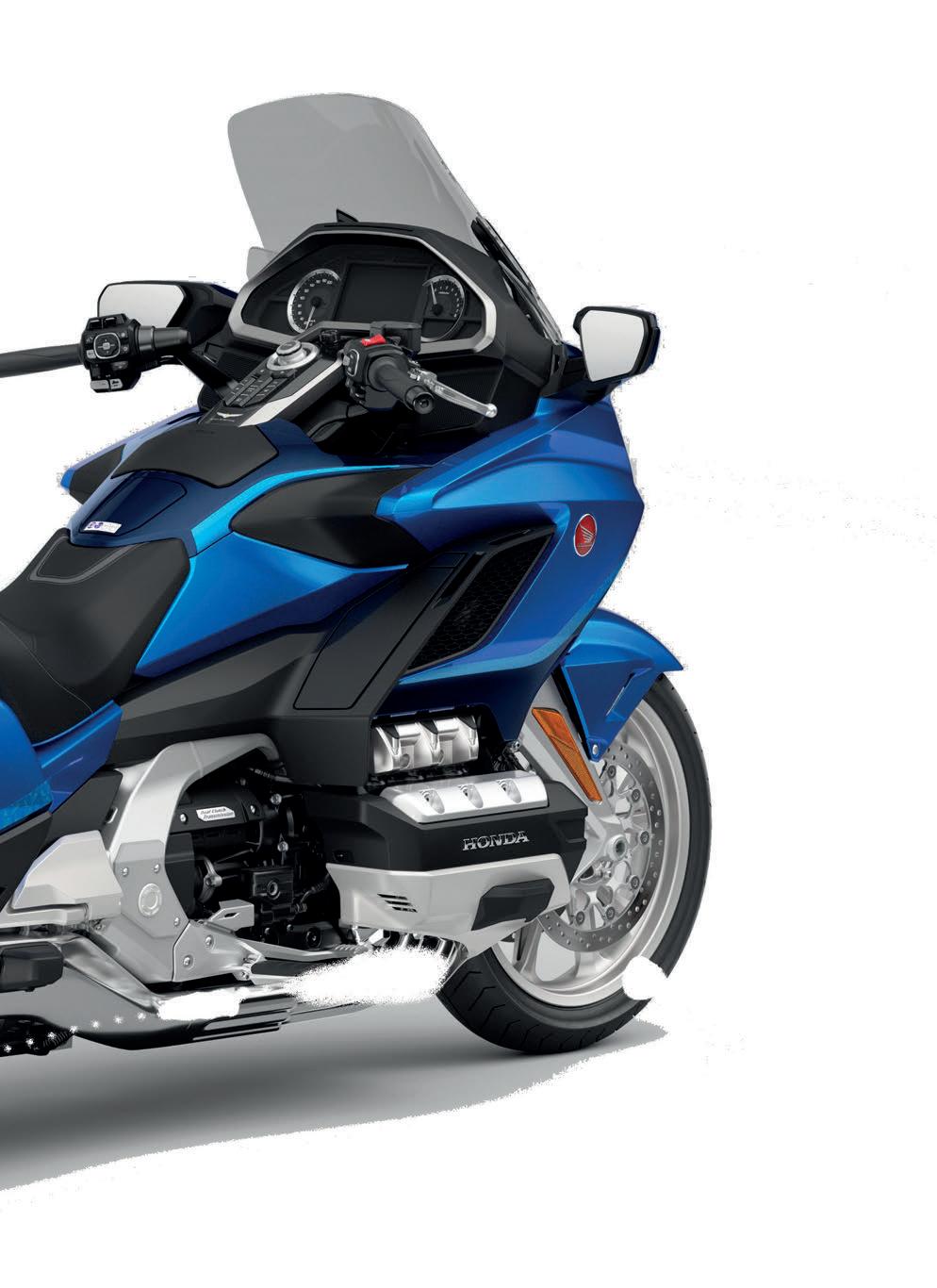

Smartphone mounts such as those made by Quad Lock let you attach your phone securely to the motorcycle’s handlebars. That way you can use your smartphone as a sat nav screen, or it can give you hands-free access to music and phone calls through a Bluetooth wireless headset. However, we’d recommend setting music playing before you set off and finding somewhere safe to stop before taking a phone call.


Standard-fit USB ports are becoming more common, especially on touring bikes and many scooters. If your bike doesn’t have one, there are many kits that let you wire a USB port into the bike to charge your phone or sat nav.
Correct tyre pressures are vital and these screw-on caps let you know if the bike’s tyres are under-inflated with a message on your phone via the app or display screen.
Rural roads are some of the most thrilling for bikers, but they also present many of the biggest challenges. Variable road surfaces, tightening bends, inattentive drivers, and changing speed limits all combine to make the countryside very challenging. This also makes it very rewarding to ride well on rural roads, which is where advanced, or


predictive, riding is key. Take nothing for granted and constantly assess the road and conditions.
Use road position to make yourself as visible as possible to all other road users, and be prepared to slow as you approach junctions, hidden driveways, and villages. Single-vehicle collisions are most common on rural roads, so adjust your speed and braking to suit.


Keeping a cool head is vital to safe riding and smooth progress in the city. A motorcycle is the perfect way to get through congested streets, so long as you plan and adapt all the time.
Filtering (overtaking queuing traffic) is one of the great perks of riding a motorcycle, but only ever pass when you know there’s a safe gap to overtake and another to pull into. Never filter where the space between traffic lanes
is tight, and go no more than 5-10mph quicker than the queuing traffic.
The Shiny Side Up campaign points out one of the major causes of biker crashes is a vehicle emerging through traffic to turn right or go straight over. Even at lower city speeds, this can cause serious injury to a motorcyclist.
Ride like the tortoise rather than the hare. Smooth, progressive riding will get you there just as quickly as aiming for every gap.


The vanishing point, or limit point, is where the two sides of the road in a bend meet at the furthest extent of your vision. If this intersection seems to be coming towards you, the corner is tightening. If it is moving further away, the bend is opening up and you can apply more throttle. Using the vanishing point is a brilliantly simple
and effective means to judge your speed, gear, braking and road position. For a right-hand bend, moving to the left of the lane will give you better vision and earlier warning of any hazards.
Being seen and being able to see on a bike are two very different but interlinked elements. Give other road users every chance to see you by wearing high-visibility riding kit. Position the bike where it can be spotted as early as possible, which is also where you will have the best view ahead. Slow down if necessary to give others time to see you, such as when you’re approaching junctions. Make eye contact with other road users. Always position the bike to give yourself the best forward vision. If you’re coming up to a left-hand bend, get over to the right of the lane – early detection is always better than heavy braking. Give yourself more space behind larger vehicles, such as trucks and buses, so others have time to see you.
The right speed in the right situation is always good. Most bikes are blessed with strong acceleration, which
The Shiny Side Up road safety partnership has been working to make the roads safer in the East Midlands for
“POSITION THE BIKE WHERE IT CAN BE SPOTTED AS EARLY AS POSSIBLE, WHICH IS ALSO WHERE YOU WILL HAVE THE BEST VIEW AHEAD“
you can use to ride away from potential danger, such as traffic lights as they turn green or pulling out of junctions. Always make sure you can stop within the limit of your vision. If you can’t, you need to adjust your speed.
Riding with a pillion lets others enjoy motorcycling. Remember to adjust your riding to give a passenger the best experience, so smooth acceleration, braking and cornering are vital. Also make sure your bike is set up to deal with the additional weight, plus any luggage you might carry.
more than 20 years. The partnership has lots of useful advice, facts and resources that can help you become a safer rider wherever you live. shinysideup.co.uk




Helite’s range of airbag jackets and vests are saving lives on the UK roads. Now the same safety benefits are available in a backpack!
Back injuries are sadly an all too familiar problem for motorcyclists. That’s why Helite has developed a wide range of products to protect you while you are on the road.
Using Helite’s inflatable motorcycle jackets, vests or backpacks could not be simpler. Just zip-up or clip-in and you are ready to be the safest you can be on your bike. Helite airbags give you added neck, back and full torso protection when
needed but still allow freedom of movement.
The Helite products detect if you are falling off your bike or are involved in an accident and inflate in just 0.094 seconds. Let’s face it, airbags in cars save lives and decrease injury everyday. Now the same can be said for motorcyclists too.
BRAND NEW!
The Helite Airbag Backpack is the latest and most advanced addition to the Helite Airbag family, offering the trusted Helite Turtle 2 technology

with the added benefit of a backpack. It’s all combined in one convenient package. Your safety is our priority. To view Helite’s full range of safety products, visit the website today. www.heliteuk.co.uk

If it is too close to the scene it could be hit by another vehicle causing further injuries – or worse.
The first of Biker Down’s three modules tells you all about incident scene management. This includes deciding who needs your help first.
It’s probably not the person making the most noise. Check anyone who is quiet and not moving first for breathing and a pulse.
Doing your best beats doing nothing
In Module 2, Biker Down moves on to casualty care. You’ll learn all sorts of techniques, including CPR (cardiopulmonary resuscitation).
The best way to learn CPR is on a course where you can practise hands on. But here
are the basics:
● Kneel next to the person and place the heel of your hand on the breastbone at the centre of their chest. Place the palm of your other hand on top of the hand on the chest. Interlock your fingers.
● Position your shoulders directly above your hands.
● Use your bodyweight (not just your arms) to press down straight by 5-6cm.
● Keeping your hands on their chest, allow the chest to return to its original position.
● Repeat these compressions 100 to 120 times a minute.
If you haven’t been on a first aid course recently, you may not be confident in the technique. But it’s better to try to save a life than to always wonder if you could have made a difference.
MYTH “ I SHOULD NEVER TAKE OFF ANOTHER BIKER’S HELMET AFTER A CRASH. ”
WRONG. If a biker’s airway is obstructed or they’re not breathing, you will need to remove their helmet to clear the airway or perform CPR with rescue breaths. Biker Down teaches how to do it.

There are first aid kits designed specifically for motorcycle use, such as those from Held and Qbag. They can be stowed under the seat, so

they’re always there when you need them. They come with all the basics to deal with cuts and burns. Look for a kit that meets the DIN 13167-2014 standard,
which is specific to motorcycles. A good quality, compact first aid kit for your bike costs from less than £10, so there’s no excuse for not carrying one.
Much of the pleasure of motorcycling is discovering new roads and the path less travelled. For some, that means following their nose, but a bit of forward planning can lead you to the best roads and still have you back in time for tea.
A map is the first stop on any route planning journey. Whether it’s a sat nav, paper map, or looking online, a topographical map in a reasonably large scale will show you all of the major, minor, and unclassified roads. When you know where you want to end up, you can simply plot a course.
A good guide is the twistier the road on a map, the more interesting it will be to ride. The trouble is, the more fun a road is to ride the more effort and restraint is needed to ride it safely. So be alert, constantly anticipate hazards, and always position your bike to give you the best possible view ahead.
Journey-planning websites will tell you if there are road closures or delays. Online bike forums are a great source of routes and which ones

to avoid because they are dangerous. Think about when you will travel and in which direction. Riding west in the evening could leave you dazzled by the glare of a setting sun. The same route at midday could be busy with local bikers, so maybe that’s when you stop for lunch.
According to the Shiny Side Up road safety partnership, biking collisions peak at around 8am and again in the later afternoon, so avoid these times if possible. If you are riding in rush-hour traffic, take extra care.
Whichever road you take, always ride within your limits.

CALIMOTO
MOTORCYCLE SAT NAV


With an average score of 4.5 out of five on App Store, Calimoto allows you to plan journeys

and provides turn-byturn voice guidance, and warnings of accident blackspots. The Premium version adds offline mapping, weather data and more.
Price Free/£49.99 yearly for Premium



66% OF MOTORCYCLE FATALITIES OCCUR ON RURAL ROADS. JUST 3% OCCUR ON MOTORWAYS. SO WHILE A MOTORWAY JOURNEY IS LESS FUN, IT’S SAFER THAN TRAVELLING ON A TWISTY COUNTRY ROAD WITH MANY POTENTIAL HAZARDS.

RISER
Use this app to find the best routes all over the world, tailored to the type of riding you prefer. There’s a social side to the app, as you can share routes and create group rides with other RISER

users. The basic version is free, the PRO version requires a subscription. Price Free/£7.99 monthly for RISER PRO

This highly


rated Apple app lets you plan routes, with a variety of modes including ‘curvy’ if you want a route that’s fun to ride. There’s also a big database of routes. The Android version of the app is out soon. Price Free (in-app purchases)

Nobody likes paying for insurance. It’s something everybody must have, but we all hope to never really need.
The good news is that motorbike insurance is usually cheaper than car insurance. According to Compare the Market’s data, covering a car costs an average of £729, but a yearly premium for a motorbike is £652.
There are all sorts of ways you can drop the price of cover without compromising on quality, but you need to make sure you find a policy that suits your needs.
Broadly speaking, you have the same choices as when insuring a car. There’s third-party cover, thirdparty, fire and theft, and fully comprehensive. We’d
“THERE ARE ALL SORTS OF WAYS TO DROP THE PRICE OF COVER WITHOUT CUTTING QUALITY“

recommend fully comp every time, as it covers repairs to your bike if it’s damaged or a replacement if it’s written off. There’s a good chance a fully comp policy will include injury cover too.
There are a few things that won’t be familiar from arranging your car insurance. One is pillion cover. Whereas your car insurance allows for carrying passengers, you need to make sure pillion
cover is included in your insurance package if you plan to take someone on the back of the bike. This insures pillions against personal injury. It’s also worth remembering that you can’t ride with a pillion passenger by law if you’re still riding on a provisional licence.
Bikes are great for commuting, slashing journey times compared with sitting in a car that’s stuck in traffic. If that’s one of your reasons for choosing two wheels, make sure your policy covers ‘social, domestic, pleasure and commuting’. If you’re going to use your bike on business – perhaps making the odd delivery – then you’ll need cover for business use as well as commuting.
On the other hand, if you always take the train to work, a ‘social, domestic and pleasure’ policy will cover everything you need.
As well as the pain of seeing a few hundred notes disappear from your bank account, nobody enjoys the hassle of arranging insurance. You can make life easier by choosing combined car and bike insurance, such as the Six Wheel Insurance cover offered by Carole Nash (carolenash.com).
If you don’t mind putting in some effort, though, it pays to get several quotes from specialists as well as using a price comparison site. The likes of Bennetts (bennetts. co.uk), BikeSure (bikesure. co.uk), and Lexham (lexhaminsurance.co.uk) specialise in cover for motorcyclists.
1. Choose your bike carefully. The fastest and most powerful bikes cost a lot to insure, so as a rule a standard or adventure machine won’t be as pricey as a top-end sports bike.
2. Limit your mileage. If you’re biking for fun rather than commuting, then you won’t cover a huge mileage each year. Choose a policy with a realistic mileage limit to cut the cost.
3. Avoid modifications. Generally speaking, a standard-spec machine will cost less to insure than one that’s modified, especially if the mod makes the bike quicker or more valuable.
4. Improve your skills. Becoming a better rider is a really satisfying process, and qualifications like BikeSafe and the Enhanced Rider Scheme can lead to discounted premiums.
5. Secure your pride and joy. Keep your bike in a garage or lockup, and fit an alarm or immobiliser.
6. Cut out extras. Don’t pay for things like pillion cover if you are never going to take a passenger.
7. Pay annually. Monthly payments usually include interest, so work out more expensive than paying in one go.
Nobody wants to crash, but make sure you’ve got this page handy just in case, along with a pen and sheet of paper. If it all goes pear-shaped, just follow the instructions.
■ Stop and warn other road users of the incident. If anybody has failed to stop, take their registration number or a description (make, model, colour). Even just a partial registration number may be of use.
■ Switch on your hazard lights and, if possible, move the vehicles to a safe place. Assess any injuries and offer first aid if you can. If anyone has been injured, contact the police or ambulance service straight away.
Date: Time:
Weather conditions (low sun, foggy, raining, sunny):
Road conditions (wet, dry, muddy):
Road where collision occurred:
Brief description of what happened, using a diagram if it helps:
Registration:
Driver’s name:
Number of occupants:
Vehicle’s insurer:
Make & model:
Description of driver:
Driver’s contact number:
Insurer’s contact number:
■ Call the police if there’s debris on the road or an obstruction to traffic; don’t put yourself in danger making the crash scene safe. Call the police if any other driver is aggressive or uncooperative.
Colour:
Policy no:

Note: If more than one other vehicle is involved, make sure you collect their details too. Fill this section in right away, so in the event of a collision, you can simply tear it out and hand it over.
Name: Contact number:
Make: Model:
Insurer:
Insurer’s contact number:
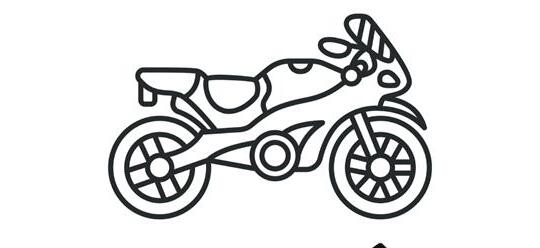
Take photos of the scene, the vehicles involved and any other damage – photograph from every angle you can.
Bike registration:
Colour:
Policy no:
I confirm that all details on this sheet are to the best of my knowledge, correct and accurate:
You: Other rider/driver:
Signed: Signed:
Date:
Date:
■ Don’t admit liability – even if you think it was your fault. If you do, it’ll only cause problems later on.
■ Don’t put yourself in danger to make the area safe – call the police and stay out of the way of any moving traffic.
■ Don’t leave any valuables behind if you have to leave the scene – damaged bikes and cars are often looted.
■ If you have a bike camera, offer the footage to your insurer and the police if they are involved.
■ Contact the police – even if you think the collision is only minor, they will have it on their records if any dispute arises.
■ Contact your insurance company as soon as possible after the collision – and certainly within 24 hours.


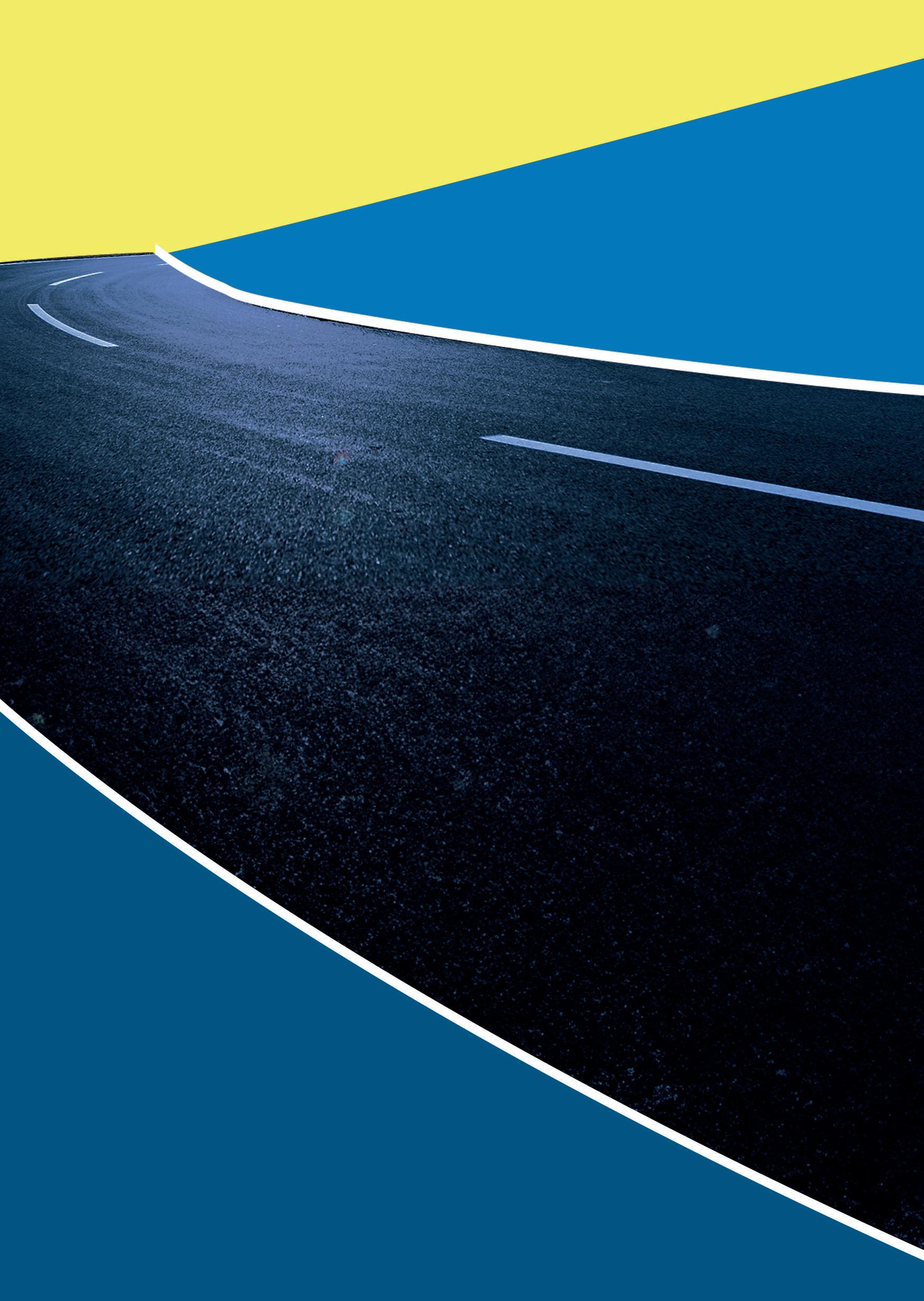

Here’s the kit you can’t do without to be comfortable, safe and secure
The one thing you cannot skimp on is your motorcycle helmet. It will keep you comfortable and, if the worst happens, save your life. Only buy one with the ECE 22.06 marking to show it meets the required standard. Also, check how well it scores in the Safety Helmet Assessment and Rating Programme (sharp.dft.gov.uk).
Good quality helmets need not be expensive, though pricier ones are generally lighter and have better ventilation. The key is to try on different makes and sizes to find one that fits well. Whether you want an open or full-face helmet, make sure it fits comfortably with no pressure points. Hold the lid firmly and try to move your head inside. If it can slide, the helmet is too big or the wrong shape for you. If you wear glasses,
make sure the helmet doesn’t pinch your ears.
Look for a helmet with a removable liner so it can be washed – nobody wants to wear a sweaty helmet. Keep the outside clean and clear from road grime and flies, and replace the helmet if it’s damaged or dropped.

“WHETHER YOU WANT AN OPEN OR FULL-FACE HELMET, MAKE SURE IT FITS COMFORTABLY WITH NO PRESSURE POINTS“
Try before you buy – wear the helmet for several minutes in the shop to make sure it’s comfy and there are no tight spots.
Snug fit – make sure the helmet is not loose or moves when you turn your head. Check the securing strap fits
neatly under your chin. Noise – earplugs help protect your ears from excessive noise while riding. Go to UltimateEar.com for a range of custom-made earplugs and earphones. A full-face helmet – gives better protection. Be sure the
1
2
1 - EYE COVER
Wear a visor or goggles with an ECE, CE or BSI approval mark. In daylight a tint of up to 50% is okay; a clear visor must be used after dark.
2 - WHAT IT’S MADE OF
A helmet is made of several protective layers: a thin hard, outer shell typically made from plastic or a composite material, then an impact-absorbing inner, followed by a soft, inner liner for cushioning, often removable for cleaning.
visor is ECE or BSI approved. Only use a dark-tinted visor in daylight. Tough stuff – helmets soften impacts using multiple layers of composite material, foam and padding. A removable inner liner makes cleaning easier.
Just as with jackets, you have a choice of leather or fabric, and the reasons for choosing either are the same. Make sure the trousers are comfortable in a seating position and they fit around your legs and knees without any tight spots. Pockets are handy but make sure you can work the zips while wearing bike gloves.
Motorcycle trousers and jackets can become very dirty, so treat leather to a good cleaner and conditioner to keep it muck-free and supple. Fabric gear can be machine washed, so just check the label.
Leather or fabric is down to personal taste, but you’ll need leather if you want to go on track days and it will need to zip securely to leather trousers. Most track riders choose a onepiece suit. For road riding, look for a jacket with good ventilation and CE-approved armour for the elbows, shoulders and back.
Fabric jackets offer better weather protection and
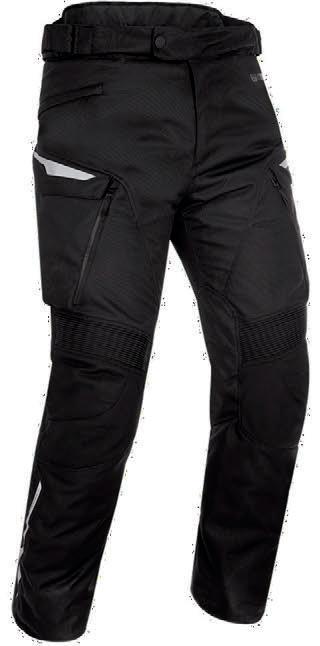
are cooler to wear in hot weather. Removable inner linings offer more insulation and weather protection. Look for a jacket with rain-proof pockets, built-in armour, and extra stitching and padding on areas likely to be affected by a crash.
Fit – before buying a jacket or trousers, try sitting on a motorcycle with the kit so you know it’s comfortable. Armour – only buy clothing with CE-approved armour, and make sure the armour doesn’t move around as you wear the kit.
Stitch up – only buy clothing that is double- or triple-stitched on the seams
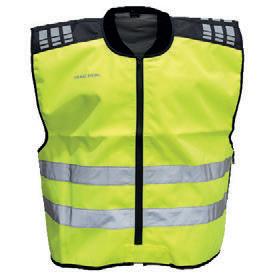

so it resists splitting if you fall off.
Zip it – always zip up your jacket when riding to give maximum protection. Check the zip is not directly touching skin in case it transmits friction heat if you fall off.
Leather – leather clothing should be at least 1.2mm thick, but make sure you are
happy with the comfort and weight.
Textile – look for layers that can be added or removed to make the clothing more waterproof or warmer depending on riding conditions.
Jeans – armoured jeans reinforced with Kevlar are another option, but offer less weather protection.
There’s a huge variety of bike boots on offer, and the type of riding you do will dictate which is best. Off-road boots are brilliant in the mud, but not so good for the daily commute in summer.
Regardless of which type appeals to you, choose boots that are comfortable both on and off the bike. Make sure they cover your ankles and have extra protection around this area.
Modern materials mean boots don’t have to be heavy and cumbersome to walk in. Women’s boots will be made to suit the different shape of female feet. Always try on

“CHOOSE BOOTS THAT ARE COMFORTABLE ON AND OFF THE BIKE. MAKE SURE THEY COVER YOUR ANKLES“

Your hands are vulnerable in a crash and you can easily lose a finger, so always wear specialist motorcycling gloves – a strong protective layer is essential.
the handlebars, so go for gloves that are a close fit but not tight. Look for double or triple stitching on areas that will suffer the most stress in a crash.
knuckles and wrist. Leather is the best choice for wear resistance, but you may want a pair of fabric gloves for better protection from the cold or rain.
Fit like a… gloves should feel tailored to your hands, but not tight. Make sure you can curl your fingers, while a wrist strap helps secure
Protection – look for gloves and boots with extra protection around knuckles and ankles to take care of these vulnerable areas.
Type of use – choose the right boots and gloves for the riding you do. Racing kit is great on track, but can be uncomfortable on a long trip. Sew good – check any gloves or boots for good quality double or triple stitching as it makes the kit strong in a crash.
If your motorcycle jacket doesn’t come with fitted armour, you can buy this separately. It’s a wise addition as it will offer muchimproved protection to your shoulders and elbows in a crash, while a back protector is vital.
Another option is an inflatable vest, such as the
Airvest that inflates in less than 0.01 seconds. As it inflates, it cushions the impact of a crash and also offers essential protection to your head and neck. Airvest also offers jackets with an integrated inflatable vest, and the vests come with a replaceable CO2 canister so they can be reused if undamaged or they can be refurbished.
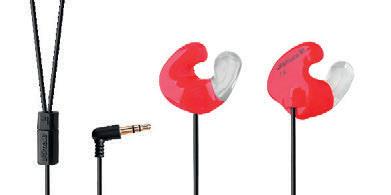
An often overlooked item for motorcyclists is ear plugs.
At 70mph, a motorcyclist can be subjected to 105dB of noise, which is like holding an electric drill to your ear, so it makes sense to use quality ear plugs to protect your ears. From simple foam plugs to custom-made reusable items, they can prevent hearing loss and tinnitus.

The Motorcyclist SoundEar from Ultimate Hearing Protection Systems costs £189 for a pair. They are custommade from soft medicalgrade silicon for a perfect fit and give 31dB of hearing protection. They also deliver high-quality audio for use with motorcycle intercoms.


Ultimate Ear Protection is the leading UK manufacturer of custom-made hearing protection for motorcyclists.
Founded in 2001 by a motorcyclist looking for a comfortable set of earplugs for biking, Ultimate now deliver hearing protection solutions to British Superbike Racers, Formula 1 Teams, and the Ministry of Defence to name a few.
Ultimate Ear Protection offer a range of products for motorcycling including our Squidgy product which offers an impressive 30dB (SNR) of noise reduction or our Soundear range which combines hearing protection with high quality audio for connectivity into intercom systems.
PLEASE USE THE COUPON FIRSTBIKE10 FOR 10% OFF ONLINE. (SCAN THE QR CODE ABOVE)
Take care of your bike so you can be confident that it’s working safely and reliably
Check for damage when cleaning your bike, such as loose wires and bolts and cracked light lenses.
It’s important to have enough fuel. Also, if you decide to lay your bike up for a long time, either fill your tank with fuel or drain it completely, or risk engine damage.

Check the pressures when the tyres are cold because the pressure will read higher when they’re hot. See that the tread depth of both tyres is greater than 1.0mm, as this is the minimum for motorcycle tyres in the UK. Clear out any small stones from within the tread and ensure there’s nothing penetrating the tyre.
Check the tension of the chain; it should have around an inch of slack. Clean and lubricate the chain regularly.
If the coolant level is low don’t use tap water! Always top-up with a mix of distilled water and anti-freeze (50% of each). Anti-freeze not only keeps the coolant from freezing in the winter, but also helps to stop your bike from overheating in the summer.
Check your bike’s lights before each ride, including indicators front and back. Remember to check that both the rear and front brake pedal/ lever operates the brake lights and give the horn a quick toot.
Check the oil level by using the dipstick or ‘spyglass’ in the side of the engine. Get the bike on its centre-stand or get someone to sit on the bike to keep it vertical. Never overfill your oil tank!
Wheel the bike along and feel for resistance or pulsing at the lever, indicating binding calipers or warped discs. Check the brakes bite when you squeeze the lever and that the pads have plenty of wear left. Make sure the level of the fluid in the brake reservoir is within the marked area.

We’ve teamed up with our partners to offer a range of goodies in our free-to-enter prize draw. One lucky winner will scoop ALL the prizes!
BIKESURE INSURANCE
Get £150 off your next bike insurance policy, redeemable against any policy taken out with Bikesure Insurance. bikesure.co.uk

Custom-made soft earplugs with filters for clear communication, protecting hearing from wind and engine noise while allowing use of helmet comms. RRP £95 ultimateear.com

Discreet GPS/RF tracker that monitors any motorcycle or moped with notification of unauthorised movements and a theft response service. RRP £259 biketrac.co.uk

FREECOM 2X SINGLE
Enjoy next-level Bluetooth communication with FREECOM 2X: crisp JBL sound, live intercom, and intuitive controls. RRP £199.95 pama.com/cardo
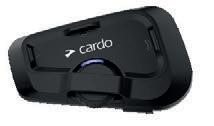
PACKTALK NEO SINGLE
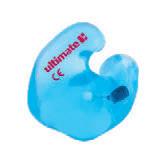
Relive the 2024 MotoGP emotions with ‘MotoGP in Focus’: a 128-page, officially licensed book featuring rare imagery and behind-the-scenes photos. RRP: £45 mtcm.link/hpda
Win a family ticket to Motorcycle Live 2026, the UK’s largest indoor motorcycle exhibition, with opportunities to ride, buy, try and enjoy all the show has to offer. RRP £51 motorcyclelive.co.uk

Cardo Systems’ PACKTALK Neo is a high-tech, Bluetoothenabled motorcycle communication headset. RRP £295.95 pama.com/cardo


The Farmyard Party in North Yorkshire is one of the largest motorcycle rallies in Europe. There’s a couple of weekend tickets up for grabs! RRP £100 farmyardparty.com
Access their legal support, discounted insurance, safety training, and community events, to enable networking with fellow enthusiasts, and a t-shirt too! RRP £58 britishmotorcyclists.co.uk




















